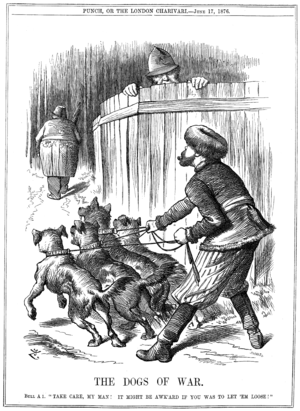The dogs of war (phrase)

In English, the dogs of war is a phrase spoken by Mark Antony in Act 3, Scene 1, line 273 of William Shakespeare's Julius Caesar: "Cry 'Havoc!', and let slip the dogs of war".
In the scene, Mark Antony is alone with Julius Caesar's body, shortly after Caesar's assassination. In a soliloquy, he reveals his intention to incite the crowd at Caesar's funeral to rise up against the assassins. Foreseeing violence throughout Italy, Antony even imagines Caesar's spirit joining in the exhortations: "ranging for revenge, with Ate by his side come hot from hell, shall in these confines with a Monarch's voice cry "Havok!" and let slip the dogs of war."
In a literal reading, "dogs" are the familiar animals, trained for warfare; "havoc" is a military order permitting the seizure of spoil after a victory and "let slip" is to release from the leash.[1][2][3] Shakespeare's source for Julius Caesar was The Life of Marcus Brutus from Plutarch's Lives, and the concept of the war dog appears in that work, in the section devoted to the Greek warrior Aratus.[4][5]
Apart from the literal meaning, a parallel can be drawn with the prologue to Henry V, where the warlike king is described as having at his heels, awaiting employment, the hounds "famine, sword and fire".[6]
Along those lines, an alternative proposed meaning is that "the dogs of war" refers figuratively to the wild pack of soldiers "let slip" by war's breakdown of civilized behavior and/or their commanders' orders to wreak "havoc", i.e., rape, pillage, and plunder.[7][8]
Yet another reading interprets "dog" in its mechanical sense ("any of various usually simple mechanical devices for holding, gripping, or fastening that consist of a spike, bar, or hook").[9] The "dogs" are "let slip" – referring to the act of releasing. Thus, the "dogs of war" are the political and societal restraints against war that operate during times of peace.
Victor Hugo used "dogs of war" as a simile for cannon fire in chapter XIV of Les Misérables:
Another cannonade was audible at some distance. At the same time that the two guns were furiously attacking the redoubt from the Rue de la Chanvrerie, two other cannons, trained one from the Rue Saint-Denis, the other from the Rue Aubry-le-Boucher, were riddling the Saint-Merry barricade. The four cannons echoed each other mournfully. The barking of these sombre dogs of war replied to each other.[10]
In modern English usage "dogs of war" is used to describe mercenaries.
The phrase has entered so far into general usage - in books, music, film and television - that it is now regarded as a cliché.[11]
References
- ↑ "dog, n1 1(d); havoc, n". Oxford English Dictionary (2nd ed.). Oxford, England: Oxford University Press. 1989.
esp[ecially] in Shakespearian phr[ase] the dogs of war
- ↑ From the fourteenth century an unauthorised call to "havoc" during battle was punishable by death. Keen, Maurice (1995). "Richard II's Ordinances of War of 1385". In Archer, Rowena; Walker, Simon. Rulers and Ruled in Late Medieval England: Essays Presented to Gerald Harriss. London: Hambledon Press. pp. 33, 36. ISBN 1-85285-133-3.
- ↑ Bate & Rasmussen (2007), p. 1834.
- ↑ Bate & Rasmussen (2007), p. 1803.
- ↑ Lives Volume XX, chapter 24, in the Bernadotte Perrin translation.
- ↑ Cornwall (1843), p. 517.
- ↑ The Phrase Finder - "Cry Havoc, and let slip the dogs of war!"
- ↑ Peter Pappas, "Shakespeare for All Time" blog. "Cry Havoc and Let Slip the Dogs of War".
- ↑ Merriam-Webster.com
- ↑
- ↑ Partridge, Eric (1940). A Dictionary of Clichés. London: Routledge. p. 253. OCLC 460036269.
Bibliography
- Shakespeare, William (2007). Bate, Jonathan; Rasmussen, Eric, eds. The RSC [Royal Shakespeare Company] Complete Works. London, GBR: Palgrave Macmillan. ISBN 0230003516. Retrieved 25 August 2015.
- Shakespere, William (1843) [1623]. "Julius Cæsar, Notes". In Cornwall, Barry; others. The Works of Shakespere, Revised From the Best Authorities: With a Memoir, and Essay on His Genius by Barry Cornwall. Also, Annotations and Introductory Remarks on the Plays, by Many Distinguished Writers. Volume II: Tragedies. Illustrated with Engravings on Wood, from Designs by Kenny Meadows. London, GBR: Robert Tyas. p. 517. OCLC 57461190. Retrieved 24 August 2015.
In military operations of old, the word 'havock; signified that no quarter should be given. By the 'dogs of war,' are probably meant famine, sword, and fire. As in 'KING HENRY V.:'— 'Leashed in like hounds, should famine, sword, and fire, Crouch for employment.' ... [SINGER].
Note: The "Notes" for "Julius Cæsar" chapter in the Cornwall edition close with the signature "SINGER.", apparently referring to contributions based on the work of Samuel Weller Singer.
See also
External links
 The dictionary definition of cry havoc at Wiktionary
The dictionary definition of cry havoc at Wiktionary
